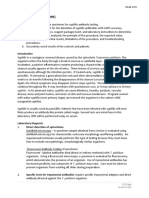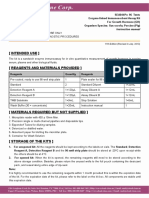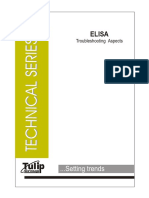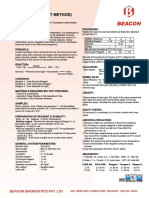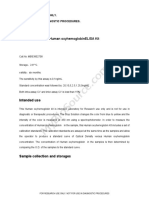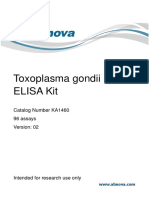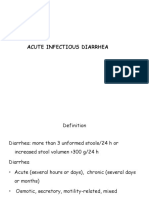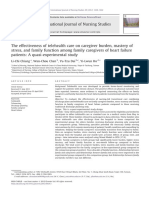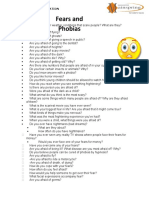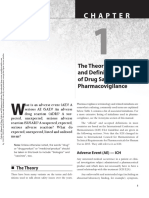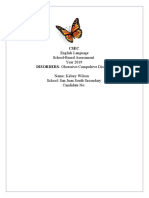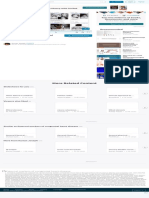0 ratings0% found this document useful (0 votes)
108 viewsRPR Test Kit
RPR Test Kit
Uploaded by
Alex LiganThis document provides instructions for using the RPR Test Kit to qualitatively and semi-quantitatively detect syphilis antibodies in serum or plasma. The RPR test detects non-treponemal antibodies through agglutination of carbon particles in the presence of reagin antibodies. Results are interpreted based on the degree of agglutination, from strong reactive to non-reactive. The kit contains carbon antigen, controls, and all materials needed except equipment to perform the test according to the provided multi-step procedure.
Copyright:
© All Rights Reserved
Available Formats
Download as PDF, TXT or read online from Scribd
RPR Test Kit
RPR Test Kit
Uploaded by
Alex Ligan0 ratings0% found this document useful (0 votes)
108 views2 pagesThis document provides instructions for using the RPR Test Kit to qualitatively and semi-quantitatively detect syphilis antibodies in serum or plasma. The RPR test detects non-treponemal antibodies through agglutination of carbon particles in the presence of reagin antibodies. Results are interpreted based on the degree of agglutination, from strong reactive to non-reactive. The kit contains carbon antigen, controls, and all materials needed except equipment to perform the test according to the provided multi-step procedure.
Original Title
RPR
Copyright
© © All Rights Reserved
Available Formats
PDF, TXT or read online from Scribd
Share this document
Did you find this document useful?
Is this content inappropriate?
This document provides instructions for using the RPR Test Kit to qualitatively and semi-quantitatively detect syphilis antibodies in serum or plasma. The RPR test detects non-treponemal antibodies through agglutination of carbon particles in the presence of reagin antibodies. Results are interpreted based on the degree of agglutination, from strong reactive to non-reactive. The kit contains carbon antigen, controls, and all materials needed except equipment to perform the test according to the provided multi-step procedure.
Copyright:
© All Rights Reserved
Available Formats
Download as PDF, TXT or read online from Scribd
Download as pdf or txt
0 ratings0% found this document useful (0 votes)
108 views2 pagesRPR Test Kit
RPR Test Kit
Uploaded by
Alex LiganThis document provides instructions for using the RPR Test Kit to qualitatively and semi-quantitatively detect syphilis antibodies in serum or plasma. The RPR test detects non-treponemal antibodies through agglutination of carbon particles in the presence of reagin antibodies. Results are interpreted based on the degree of agglutination, from strong reactive to non-reactive. The kit contains carbon antigen, controls, and all materials needed except equipment to perform the test according to the provided multi-step procedure.
Copyright:
© All Rights Reserved
Available Formats
Download as PDF, TXT or read online from Scribd
Download as pdf or txt
You are on page 1of 2
RPR Test Kit
RPR/010* & RPR/012*
*Suffixes indicate change in kit presentation only.
PRINCIPLE MATERIALS AND EQUIPMENT REQUIRED BUT NOT
The RPR (Rapid plasma reagin), test kit is a non-Treponemal test for the PROVIDED.
qualitative and semi-quantitative detection of syphilis using serum Specimen collection container, Serological pipettes (50 & 100μl),
(heated or unheated), or plasma. The RPR test consists of modified timer, rotating table (100rpm), 0.85% physiological saline, glass
VDRL antigen containing carbon particles, which aggregates in the test tubes.
presence of reagin type antibodies in serum or plasma, indicating a
positive result. RECOMMENDATIONS AND CONTROLS
It is recommended that the positive and negative controls are run
CLINICAL SIGNIFICANCE with each batch of test specimens. For the assay to be valid the
The RPR test is “non-treponemal” in that the antibodies detected are not positive control provided should give a strong positive pattern and
specific for T. pallidum, although their presence in patient’s serum or the negative control provided should give a clearly negative result.
plasma is strongly associated with infection by the organism. This test
measures antibody (IgG and IgM) produced in response to lipoidal RECOMMENDED PROCEDURE
material released from damaged host cells as well as to lipoprotein-like A. Qualitative Test
material released from the spirochaetes. These antibodies tend to 1. Draw the sample into the pipstir provided taking care not to
disappear after successful treatment of the infection. transfer and cellular matter.
2. Hold the pipstir vertically above the test card and allow one
WARNINGS AND PRECAUTIONS drop (50µl), of specimen to dispense onto the test card.
For in vitro diagnostic use only. For professional use only. 3. Spread the specimen evenly over the area of the test circle
Health and Safety warnings: using the broad end of the pipstir.
All patient samples and reagents should be treated as potentially 4. Ensure the carbon antigen is shaken and homogenous.
infectious and the user must wear protective gloves, eye protection and 5. Attach the needle to the dispenser and withdraw sufficient
laboratory coats when performing the test. carbon antigen.
Non disposable apparatus must be sterilised after use by an appropriate 6. Dispense a single drop (20µl) of antigen into the centre of the
method. specimen ensuring the dispenser is held vertically.
Disposable apparatus must be treated as biohazardous waste and 7. Rotate card on rotating table for 8 minutes.
autoclaved or incinerated. 8. Read the results macroscopically.
Spillages of potentially infectious material should be absorbed and
disposed of as above. The site of spillage must be sterilised with B. Semi Quantative Test
disinfectant or 70% alcohol. 1. Prepare doubling dilutions of the sample from the undiluted
Do not pipette by mouth. specimen to 1:32 using physiological saline.
If a reagent vial is compromised, discard the contents immediately. 2. Using the pipstirs, place one drop (50µl), of each dilution onto
The product also contains aqueous buffer salts including sodium azide separate test card circles.
as preservative - see material safety data sheet. 3. Using the broad end of the pipster, spread each dilution over
Analytical precautions: the test circle area from weakest to strongest dilution.
Do not modify the test procedure. 4. Continue procedure as from point 4.of the Qualitative test.
All reagents are ready to use do not dilute the reagents in any way.
Reagents and samples to be used at room temperature (18-30ºC). INTERPRETATION OF RESULTS
Shake reagents before use to ensure a homogenous suspension A. Qualitative Test
Avoid cross contamination between different reagents. Positive: Macroscopic agglutination constitutes a positive test
Do not interchange droppers. The disposable pipettes should be result within the accepted limitations of the test procedure,
discarded after a single use. therefore indicating the presence of the antibodies to T.Pallidum.
Discard reagents if they become contaminated or incorrect results are Negative: No macroscopic agglutination constitutes a negative test
obtained with the controls. result within the accepted limitations of the test procedure,
Do not mix reagent of different lots. therefore indicating the absence of the antibodies to T.Pallidum.
B. Semi Quantitative Test
STANDARD KIT COMPONENTS Results can be graded from strong to non-reactive and the titre
RPR/010 RPR/012 expressed as the reciprocal of the last dilution showing a positive
COMPONENT
(100T) (500T) reaction.
RPR Carbon 2ml 10ml Strong Large clumps of carbon particles with a
Positive Control 0.5ml 1ml Reactive (SR) clear background.
Negative Control 0.5ml 1ml Large clumps of carbon particles, more
Reactive (R)
Pipette Stirrers 100 500 dispersed than strong reactive.
Dispenser 1 1 Weak Reactive Small clumps of carbon particles with
Needle 1 1 (WR) light grey background.
Reaction Cards 10 50 Slight clumping of carbon particles,
Instructions For Use 1 1 typically seen as a button of aggregates
Trace Reactive
in the centre of the test circle or
(TR)
dispersed around the edge of the test
SPECIMEN AND SAMPLE PREPARATION
circle.
This kit can be used with plasma or heated serum. Do not use samples
that are haemolysed, turbid or lipaemic. Store at 2-8ºC for up to 7 days A smooth grey pattern or a button of
Non-Reactive
before testing. If longer storage is required, freeze sample at -20ºC or non-aggregated carbon particles in the
(NR)
lower. Ensure frozen samples are thawed before testing. centre of the test circle.
Reactive samples should be recorded as antibody positive and
must be subjected to further tests to determine the presence or
absence of specific anti-Treponemal antibody.
REACTION STABILITY BIBLIOGRAPHY
Read test immediately after rotation. Exercise caution when interpreting 1. McGrew, B.E. et al., Amer. J. Med Tech. , 34, 634 (1968a).
results carried out at temperatures other than that recommended. 2. McGrew, B.E. et al., Amer. J. Clin. Path., 50, 52 (1968b).
3. Norins, L.C. Automation in Clinical Chemistry, 1, 157New
STORAGE AND SHELF LIFE York Mediad (1968).
Store all reagents upright at 2-8ºC. 4. Portnoy, J. et al., U.S. Publ. Health Report, 77, 645 (1962).
DO NOT FREEZE THE REAGENT. 5. Schroeter, A.L. et al.,Adv. In Automated Analysis 1, 256 N.Y.
Do not use reagents after the stated expiry date. Mediad
Discard reagents if they become contaminated. 6. Stevens, R.W. and Stroebel, E., Amer. J. Clin. Path., 53, 32
ALL REAGENTS ARE SUPPLIED READY TO USE (1970).
7. Stout, G.W. et al., J. Conf. Pub. Health Lab. Directors, 26, 7,
LIMITATIONS OF THE METHOD (1968).
1. All reagin tests may give a small proportion of false positive results. 8. Manual Test for Syphilis PHS Publications No 411, (1969).
Diseases such as infectious mononucleosis, leprosy, lupus
erythematous, vaccinia and viral pneumonia can cause such TABLE OF SYMBOLS
reactions. SYMBOL DEFINITION
2. Reactive RPR test specimens should be tested with further
serological tests (i.e. TPHA and FTA-abs), as with any serological Batch Number
procedure, the diagnosis should not be made on a single reactive
result. In-vitro Diagnostics
3. As with other serological tests, the RPR test cannot distinguish
between syphilis and other pathogenic Treponemal infections e.g.
Yaws. Catalogue reference
4. A diagnosis should always be made in conjunction with clinical
findings. Store at
5. False positive/negative results can also occur due to:
• Contamination of test materials
• Improper storage, or test temperatures Expiry date
• Deviation from the Recommended Procedures.
Manufactured by
PERFORMANCE CHARACTERISTICS
The following materials were independently tested to compare the
performance of the RPR reagent with that of a reference reagent from Date of Manufacture
CDC Atlanta and a reagent from another manufacturer.
Read the instructions
Reference plasma panel from CDC Atlanta for use
Positive test panel from a UK hospital ∑
Normal donor plasma Sufficient for
WHO control
All specimens gave 100% concordant qualitative results with all
reagents.
Intra-assay Precision and Accuracy: CV = 0%, accuracy = +/- 0%.
Inter-assay Precision: A standard positive sample tested on eight
occasions showed +/- 1 doubling dilution from the nominal value.
DISCLAIMER
The user is responsible for the performance of the reagent by any
method other than those mentioned in the Recommended Procedures.
Any deviations from the Recommended Procedures should be
validated prior to use.
Lab21 Healthcare Ltd. TEL: +44 (0) 1276 600081 2020-02 PTEC.RPR.IFU.V4
Unit 1 Watchmoor Point FAX: +44 (0) 1276 600151
Watchmoor Road WEB: Lab21healthcare.com
Camberley, Surrey, EMAIL: Enquiries.lab21healthcare@novacyt.com
GU15 3AD, UK
Part of the Novacyt Group REGISTERED NUMBER: 02957012
You might also like
- Insert - Elecsys T3.ms - 11731360122.v26.enDocument4 pagesInsert - Elecsys T3.ms - 11731360122.v26.enGuneyden Guneyden100% (3)
- Teco RPR Package InsertDocument2 pagesTeco RPR Package InsertÀnn DyNo ratings yet
- RPR - Latex - Test - Kit - 500100 100 31 - 500100 500 31 (11 10 2015)Document3 pagesRPR - Latex - Test - Kit - 500100 100 31 - 500100 500 31 (11 10 2015)ita91itaNo ratings yet
- RPR Latex Test Kit: Assay ProcedureDocument3 pagesRPR Latex Test Kit: Assay Procedureces8bautistaNo ratings yet
- CEPI044A RPR Carbon Kit Issue 06 IFUDocument2 pagesCEPI044A RPR Carbon Kit Issue 06 IFUslh labNo ratings yet
- RPR Card Test: Laboratories For Information On Handling Human SpecimensDocument3 pagesRPR Card Test: Laboratories For Information On Handling Human SpecimensHandhi Montok SetiawanNo ratings yet
- Komposisi Reagen RPR SyphilisDocument3 pagesKomposisi Reagen RPR SyphilisRiky Achmad SasmitaNo ratings yet
- CombiWidal - S - 240504 - 102153Document2 pagesCombiWidal - S - 240504 - 102153Ventas1 VidLabNo ratings yet
- Blood Grouping Package InsertDocument2 pagesBlood Grouping Package Insertsandra garzonNo ratings yet
- Tpla2: Sample Volumes Sample Sample DilutionDocument3 pagesTpla2: Sample Volumes Sample Sample DilutionhairiNo ratings yet
- RPR-carbon: Qualitative Determination of Plasma ReaginsDocument2 pagesRPR-carbon: Qualitative Determination of Plasma ReaginsRegina Herrera RodriguezNo ratings yet
- A1 and A2 Sub-Types of Blood Group A A ReflectioDocument2 pagesA1 and A2 Sub-Types of Blood Group A A Reflectio2010035No ratings yet
- Vital Widal IfuDocument2 pagesVital Widal IfuMuhammad Rizaldi RidwanNo ratings yet
- Lorne Laboratories LTD.: Great BritainDocument2 pagesLorne Laboratories LTD.: Great BritainandhiNo ratings yet
- Rapid Plasma Reagin 2020Document6 pagesRapid Plasma Reagin 2020REMAN ALINGASANo ratings yet
- ELISA Kit For Vitamin D3 (VD3) CEA920GeDocument9 pagesELISA Kit For Vitamin D3 (VD3) CEA920Gebambang purwantoNo ratings yet
- (Intended Use) : Instruction ManualDocument8 pages(Intended Use) : Instruction ManualNitin KeshavNo ratings yet
- Measure H-FabpDocument2 pagesMeasure H-Fabptuan vănNo ratings yet
- 1 (2 Files Merged)Document2 pages1 (2 Files Merged)HOTMAIDANo ratings yet
- Manual ANA ElisaDocument10 pagesManual ANA ElisaDaniel Mojica VegaNo ratings yet
- SerodiaTP-PA KitInsert 101606Document4 pagesSerodiaTP-PA KitInsert 101606rdtcartoonsNo ratings yet
- RF 8IU-Teco Kit 10.2018 FinalDocument2 pagesRF 8IU-Teco Kit 10.2018 FinalMiguel Enrique Castro CruzNo ratings yet
- Sodium Reagent Kit (Mono Test) : Colorimetric MethodDocument1 pageSodium Reagent Kit (Mono Test) : Colorimetric MethodFazal RazaNo ratings yet
- Asi RFDocument4 pagesAsi RFcarineNo ratings yet
- 1116005I Rev. 02Document2 pages1116005I Rev. 02kirubel demelashNo ratings yet
- MBS3809170Document4 pagesMBS3809170mahmoudarif2020No ratings yet
- Atlas Medical ABO RH Blood Grouping InsertDocument3 pagesAtlas Medical ABO RH Blood Grouping InsertDr.Maryam MastoorNo ratings yet
- ELISA Kit For Fetoprotein Alpha (AFP) E90153BoDocument8 pagesELISA Kit For Fetoprotein Alpha (AFP) E90153BoRo KohnNo ratings yet
- Ifu Proteus Oxk, Ox2, Ox19Document2 pagesIfu Proteus Oxk, Ox2, Ox19sharmashyamsinghNo ratings yet
- A TpoDocument4 pagesA TpoJimboreanu György PaulaNo ratings yet
- Elisa: Troubleshooting AspectsDocument19 pagesElisa: Troubleshooting AspectsRonel MendozaNo ratings yet
- Sifilis RPR HumanDocument1 pageSifilis RPR HumanfabrisiaNo ratings yet
- VDRL Product Insert1Document7 pagesVDRL Product Insert1HarshvardhanNo ratings yet
- Specimens: Architect) As Standard TestDocument12 pagesSpecimens: Architect) As Standard TestMostafa Adel AhmdNo ratings yet
- Protocolo DQO HachDocument6 pagesProtocolo DQO HachRosalva Angulo ReyesNo ratings yet
- 1105000I Rev. 02Document2 pages1105000I Rev. 02Riadh BenyoucefNo ratings yet
- Measure AmyDocument2 pagesMeasure Amytuan vănNo ratings yet
- ACCENT-200 ALPHA-FETOPROTEIN ADocument2 pagesACCENT-200 ALPHA-FETOPROTEIN Aemc.medicalserviceNo ratings yet
- UREA Berthlot PDFDocument1 pageUREA Berthlot PDFDiegoNo ratings yet
- Widal 8x5mlDocument2 pagesWidal 8x5mlLễ Phan ThịNo ratings yet
- TECO CRP Package InsertDocument2 pagesTECO CRP Package InsertYosselyn Chilon VelasquezNo ratings yet
- RF TurbilatexDocument2 pagesRF TurbilatexAhmed YhyaNo ratings yet
- MEASURE HbA1c (Fixed)Document2 pagesMEASURE HbA1c (Fixed)Trần Văn Bình100% (1)
- Eia 3989Document7 pagesEia 3989yousrazeidan1979No ratings yet
- Nephchem ASODocument1 pageNephchem ASOsobujNo ratings yet
- Alp PDFDocument1 pageAlp PDFDhita Ariefta PNo ratings yet
- 18 - Laboratory Procedure Handout For RFDocument5 pages18 - Laboratory Procedure Handout For RFkvprasadchNo ratings yet
- VDRL Stabilized: Qualitative Determination of Plasma ReaginsDocument2 pagesVDRL Stabilized: Qualitative Determination of Plasma ReaginsxlkoNo ratings yet
- Mbs 3802708Document5 pagesMbs 3802708Karina CarrascoNo ratings yet
- Kit Insert Anti Toxoplasma Gondii IgGDocument13 pagesKit Insert Anti Toxoplasma Gondii IgGAghnia Asy S.No ratings yet
- Alkaline Phosphatase (Dea) : Manufacturer: Biolabo SasDocument2 pagesAlkaline Phosphatase (Dea) : Manufacturer: Biolabo SasRury Darwa Ningrum100% (1)
- Anti-H Lectin Eng Rev01Document1 pageAnti-H Lectin Eng Rev01Ventas2lp IcerlabNo ratings yet
- TOTAL PROTEIN (Biuret Method) : Code No. Pack Size Reagent 1 Reagent 2Document1 pageTOTAL PROTEIN (Biuret Method) : Code No. Pack Size Reagent 1 Reagent 2Eddafe100% (1)
- FERRITINDocument2 pagesFERRITINMira SafwatNo ratings yet
- Rheumatoid FactorDocument1 pageRheumatoid FactorDevany AlzahraNo ratings yet
- RF Latex Test Kit: Intended Use PrecautionsDocument2 pagesRF Latex Test Kit: Intended Use Precautionsces8bautistaNo ratings yet
- ELISA Kit For Sirtuin 1 (SIRT1) SEE912HuDocument9 pagesELISA Kit For Sirtuin 1 (SIRT1) SEE912Hufitriani fajriNo ratings yet
- 3.1.1 HBsAg Testing (ELISA Method)Document6 pages3.1.1 HBsAg Testing (ELISA Method)BALAJINo ratings yet
- 3.1.1 HBsAg Testing (ELISA Method)Document6 pages3.1.1 HBsAg Testing (ELISA Method)Jeevan VkiNo ratings yet
- Picture 1Document28 pagesPicture 1Alex LiganNo ratings yet
- Week-11 VirologyDocument8 pagesWeek-11 VirologyAlex LiganNo ratings yet
- Week-12 VirologyDocument8 pagesWeek-12 VirologyAlex LiganNo ratings yet
- Potassium SodiumDocument2 pagesPotassium SodiumAlex LiganNo ratings yet
- PDF Community Health Nursing Action Plan - CompressDocument4 pagesPDF Community Health Nursing Action Plan - CompressAlex LiganNo ratings yet
- Community and Public Health FortpolioDocument25 pagesCommunity and Public Health FortpolioAlex LiganNo ratings yet
- Clinical Microscopy 1 Test Review and Case Studies Jethro Rada JRDocument34 pagesClinical Microscopy 1 Test Review and Case Studies Jethro Rada JRAlex LiganNo ratings yet
- Case Study - Synovial Fluid NotesDocument7 pagesCase Study - Synovial Fluid NotesAlex LiganNo ratings yet
- Laboratory Diagnosis Bacterial Meningitis: Gray'Document16 pagesLaboratory Diagnosis Bacterial Meningitis: Gray'Alex LiganNo ratings yet
- Staining Chapters 16 - 20Document97 pagesStaining Chapters 16 - 20Alex LiganNo ratings yet
- Diagnostic Microbiology NotesDocument2 pagesDiagnostic Microbiology NotesAlex LiganNo ratings yet
- PE1 Module 4Document8 pagesPE1 Module 4Jarah Clarish Deloso100% (1)
- Wahyuni (2022)Document10 pagesWahyuni (2022)Syafrudin Imam NegaraNo ratings yet
- Diagnostics: Efficiently Classifying Lung Sounds Through Depthwise Separable CNN Models With Fused STFT and MFCC FeaturesDocument12 pagesDiagnostics: Efficiently Classifying Lung Sounds Through Depthwise Separable CNN Models With Fused STFT and MFCC FeaturesJehad Ur RahmanNo ratings yet
- Infectious DiarrheaDocument85 pagesInfectious DiarrheaTarikNo ratings yet
- Prosthodontic Management of Compromised Ridges and SituationsDocument8 pagesProsthodontic Management of Compromised Ridges and Situationskhalisha salsabila100% (2)
- Diagnostic Value of Non Invasive Liver Function Tests in Liver Fibrosis and Changes in These Parameters Post Metabolic SurgeryDocument7 pagesDiagnostic Value of Non Invasive Liver Function Tests in Liver Fibrosis and Changes in These Parameters Post Metabolic SurgeryTan BulNo ratings yet
- Chiang Et Al., 2012Document13 pagesChiang Et Al., 2012Karen TjiaNo ratings yet
- Fears and Phobias: Course: Conversation Class 27Document8 pagesFears and Phobias: Course: Conversation Class 27Eliana GodoyNo ratings yet
- Nutrition During Old AgeDocument24 pagesNutrition During Old AgeAnam Fatima100% (1)
- Tabel POMR Senin Malam 161023Document8 pagesTabel POMR Senin Malam 161023bondkaboomNo ratings yet
- M13 - Dermatology - Chapter 7Document8 pagesM13 - Dermatology - Chapter 7Idham BaharudinNo ratings yet
- X ChromosomeDocument23 pagesX ChromosomeAlanGarciaNo ratings yet
- Volume-3 - Issue - 10 October 2020: Management of Nidranasha (Insomnia) Through Ayurveda: A ReviewDocument12 pagesVolume-3 - Issue - 10 October 2020: Management of Nidranasha (Insomnia) Through Ayurveda: A ReviewRajeshwar KambleNo ratings yet
- Chapter 28Document14 pagesChapter 28ram sunderNo ratings yet
- Serous Fluid: FormationDocument4 pagesSerous Fluid: FormationemmanuelNo ratings yet
- How Coronavirus Is Treated With TCM in China by John K Chen v3Document136 pagesHow Coronavirus Is Treated With TCM in China by John K Chen v3dokan42No ratings yet
- Argumentative Persuasive Essay SampleDocument1 pageArgumentative Persuasive Essay Samplejulian bakerNo ratings yet
- The Theory and Definitions of Drug Safety - PharmacovigilanceDocument7 pagesThe Theory and Definitions of Drug Safety - PharmacovigilancemwdhtirahNo ratings yet
- 4 Hour Heat Stress Training Student Manual 508Document42 pages4 Hour Heat Stress Training Student Manual 508ZakirhasNo ratings yet
- English SbaDocument13 pagesEnglish SbaKelsey Wilson0% (1)
- Failures in Fixed Partial Dentures: Dr. Rohit FernandezDocument89 pagesFailures in Fixed Partial Dentures: Dr. Rohit FernandezPriyanka GandhiNo ratings yet
- External Markers of Congenital Heart DiseaseDocument1 pageExternal Markers of Congenital Heart DiseaseSrinivas DhangarNo ratings yet
- p2371 Sample Chapter 4Document22 pagesp2371 Sample Chapter 4Kayla Andrea CalibaNo ratings yet
- Imaging of Central Nervous System Autoimmune, Paraneoplastic, and Neuro-Rheumatologic DisordersDocument37 pagesImaging of Central Nervous System Autoimmune, Paraneoplastic, and Neuro-Rheumatologic DisordersBALEWNo ratings yet
- Cardiovascular SystemDocument37 pagesCardiovascular SystemHira KhanNo ratings yet
- Mobility Aids With VideoDocument92 pagesMobility Aids With VideoRadha KrishnanNo ratings yet
- Asthma PrioDocument2 pagesAsthma PrioHugh Klied ItuhatNo ratings yet
- Final Rwanda Hospital Accreditation Standards Performance Assessment 3 Edition 2022Document168 pagesFinal Rwanda Hospital Accreditation Standards Performance Assessment 3 Edition 2022john peter BamporikiNo ratings yet
- Upper Gastrointestinal DisordersDocument40 pagesUpper Gastrointestinal DisordersNoemi GarciaNo ratings yet
- Read The Following Text Very Carefully To Get A General Impression of It, Analyze It and Then Do The Exercises That FollowDocument3 pagesRead The Following Text Very Carefully To Get A General Impression of It, Analyze It and Then Do The Exercises That FollowAinita KusmawatiNo ratings yet














